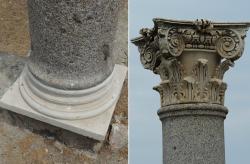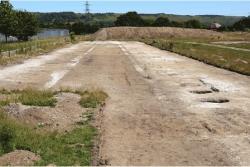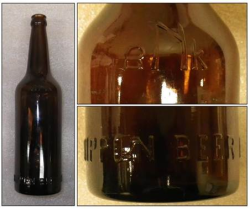INSTITUT SUPERIEUR D'ANTHROPOLOGIE
INSTITUTE OF ANTHROPOLOGY
ONLINE COURSES / COURS A DISTANCE
FALL TERM : OCTOBER 2015
REGISTER NOW
NOUVELLE ZELANDE –  Wellington - A glass inkwell, several porcelain dolls’ heads, a china elephant with a little girl riding on top and an early ginger beer bottle are among the things discovered in old wells during the Victoria Street transformation work. Another unusual find is the intact, head-shaped bowl of an old clay smoking pipe depicting a bearded man in a cavalry helmet. Though most of the upgrade work was close to the surface, four wells were discovered as construction workers installed 9000 metres of new ducting pipes for existing and future underground services, and dug the pits for the 55 new trees that now line both sides of the street. Archaeologist Sarah Phear from Clough and Associates, who has begun assessing the finds, says the well that revealed the most interesting artefacts was in an area of Te Aro where several schoolrooms were located from the 1850s. These included St Peter’s Schoolroom and the Te Aro Infants’ School near the Ghuznee Street corner. “These school buildings could explain the collection of little china dolls’ heads that were found,” she says. The parts of Victoria Street that have been upgraded were busy residential areas in the 19th century and first few decades of the 20th century and early on most people had their own wells.
Wellington - A glass inkwell, several porcelain dolls’ heads, a china elephant with a little girl riding on top and an early ginger beer bottle are among the things discovered in old wells during the Victoria Street transformation work. Another unusual find is the intact, head-shaped bowl of an old clay smoking pipe depicting a bearded man in a cavalry helmet. Though most of the upgrade work was close to the surface, four wells were discovered as construction workers installed 9000 metres of new ducting pipes for existing and future underground services, and dug the pits for the 55 new trees that now line both sides of the street. Archaeologist Sarah Phear from Clough and Associates, who has begun assessing the finds, says the well that revealed the most interesting artefacts was in an area of Te Aro where several schoolrooms were located from the 1850s. These included St Peter’s Schoolroom and the Te Aro Infants’ School near the Ghuznee Street corner. “These school buildings could explain the collection of little china dolls’ heads that were found,” she says. The parts of Victoria Street that have been upgraded were busy residential areas in the 19th century and first few decades of the 20th century and early on most people had their own wells.
http://www.scoop.co.nz/stories/AK1507/S00050/china-heads-among-victoria-street-finds.htm
ITALIE –  Giannutri - The remains of one of the most prestigious maritime villas from Roman times are set to reopen July 2 in a small, almost uninhabited island off the Tuscan coast after been locked for 15 years. Commonly known as “Villa Domitia,” the imperial complex stood magnificently 2,000 years ago on the island of Giannutri, a rocky crescent about 3 miles long with thick areas of Mediterranean vegetation. "The villa was built on a harsh, uninhabited site, "Paola Rendini, of the archaeological superintendency of Tuscany, told Discovery News. "There is no water spring on the island, and raw materials had to be carried from the mainland. It was a huge task," Despite such difficulties, the Romans managed to shape up a sprawling "otium" (leisure) villa, lavishly decorated with precious marbles, mosaics and frescoes. The majestic complex marks Giannutri’s most glorious time.
Giannutri - The remains of one of the most prestigious maritime villas from Roman times are set to reopen July 2 in a small, almost uninhabited island off the Tuscan coast after been locked for 15 years. Commonly known as “Villa Domitia,” the imperial complex stood magnificently 2,000 years ago on the island of Giannutri, a rocky crescent about 3 miles long with thick areas of Mediterranean vegetation. "The villa was built on a harsh, uninhabited site, "Paola Rendini, of the archaeological superintendency of Tuscany, told Discovery News. "There is no water spring on the island, and raw materials had to be carried from the mainland. It was a huge task," Despite such difficulties, the Romans managed to shape up a sprawling "otium" (leisure) villa, lavishly decorated with precious marbles, mosaics and frescoes. The majestic complex marks Giannutri’s most glorious time.
http://news.discovery.com/history/roman-villa-reopens-on-wild-tuscan-island-150701.htm
ROYAUME UNI –  Folkestone - The building of a new housing development at Shorncliffe Garrison could be delayed after architects found structures dating back to nearly 2,500 years ago. Historical finds have been made at St Martin's Plain. "An Iron Age bank and ditch has been discovered at the site, as well as a period army camp from the First World War.
Folkestone - The building of a new housing development at Shorncliffe Garrison could be delayed after architects found structures dating back to nearly 2,500 years ago. Historical finds have been made at St Martin's Plain. "An Iron Age bank and ditch has been discovered at the site, as well as a period army camp from the First World War.
http://www.folkestoneherald.co.uk/Iron-Age-halts-work-new-homes/story-26812192-detail/story.html
VIET NAM –  Da Nang - More than 4,500 items, including ceramics, stone axes, coins, mollusc shells dating back to the 3,000-year-old Sa Huynh Culture, were found during a two-month excavation in the garden of the Khue Bac Communal House in Da Nang. Archaeologist Pham Van Trieu, who led the excavation, said items on the 100sq.m area in Khue Bac Communal House, which lies at the foot of the Ngu Hanh Son (Marble) Mountains 15km from the city, feature layers of culture covering the Sa Huynh, Champa and Dai Viet (Great Viet Nam) eras, and trade with China's Ming and Song dynasties. "The location is situated near an ancient channel running around mountains and connecting it with the Co Co River," Trieu said. "It was a residential area for people during the Sa Huynh Culture as shown by the stone axes, knives and grindstone," he said. Trieu said stone pestles, which were used to crush seeds and pound food, were also found in the area. "Ceramic fragments feature 11 patterns from the Sa Huynh Culture. Potters used to move around a table to mould ceramic items. They did not use the potter's wheel as people do now," he said. He added that Vietnamese terra-cotta pieces from 14th century, and Chinese ceramic fragments from the eighth or ninth century and coins (1024-64) were found in the area. An archeological team from Viet Nam Archaeology Institute also dug up two sites at the Xuan Duong Cham tower in Lien Chieu District and found 166 items including bricks and a possible holy hole that were a feature of most Cham towers. The team said it would have been a large tower from the 11th century, facing the Han estuary. It would act as a religious centre and a light house for boats travelling up river from the sea. Ceramic pieces of the Sa Huynh, Champa and Vietnamese dated back from first and second centuries were also unearthed at the Go Gian tower in Hoa Vang district. Local residents also found a sandstone "yoni" and head of Shiva when they restored a temple in the area early this year.
Da Nang - More than 4,500 items, including ceramics, stone axes, coins, mollusc shells dating back to the 3,000-year-old Sa Huynh Culture, were found during a two-month excavation in the garden of the Khue Bac Communal House in Da Nang. Archaeologist Pham Van Trieu, who led the excavation, said items on the 100sq.m area in Khue Bac Communal House, which lies at the foot of the Ngu Hanh Son (Marble) Mountains 15km from the city, feature layers of culture covering the Sa Huynh, Champa and Dai Viet (Great Viet Nam) eras, and trade with China's Ming and Song dynasties. "The location is situated near an ancient channel running around mountains and connecting it with the Co Co River," Trieu said. "It was a residential area for people during the Sa Huynh Culture as shown by the stone axes, knives and grindstone," he said. Trieu said stone pestles, which were used to crush seeds and pound food, were also found in the area. "Ceramic fragments feature 11 patterns from the Sa Huynh Culture. Potters used to move around a table to mould ceramic items. They did not use the potter's wheel as people do now," he said. He added that Vietnamese terra-cotta pieces from 14th century, and Chinese ceramic fragments from the eighth or ninth century and coins (1024-64) were found in the area. An archeological team from Viet Nam Archaeology Institute also dug up two sites at the Xuan Duong Cham tower in Lien Chieu District and found 166 items including bricks and a possible holy hole that were a feature of most Cham towers. The team said it would have been a large tower from the 11th century, facing the Han estuary. It would act as a religious centre and a light house for boats travelling up river from the sea. Ceramic pieces of the Sa Huynh, Champa and Vietnamese dated back from first and second centuries were also unearthed at the Go Gian tower in Hoa Vang district. Local residents also found a sandstone "yoni" and head of Shiva when they restored a temple in the area early this year.
USA –  San Felipe - When the residents evacuated San Felipe in 1836, they smashed what they couldn’t take with them and razed the town to keep it out of the hands of Gen. Antonio Lopez de Santa Anna and his advancing Mexican Army. What little they left behind is still there, well preserved and generally unmolested under a couple feet of dirt for the past 179 years. For the last two weeks, state archaeologists have been digging in the dirt at what is now San Felipe de Austin State Historic Site uncovering the remains of one of the town’s most prominent structures, the Farmer’s Hotel. It’s one of the few buildings that had a basement and thus something to recover. “Last year we were trying to find the four corners of the basement and we found one corner,” said Jeff Durst, regional archaeologist for the Texas Historical Commission. “This year we’re continuing our search for the other three corners and are attempting to determine the depth of the basement.” When the town burned down during the Texas Revolution in the event known as the Runaway Scrape, it was never rebuilt on its original location. The current town of San Felipe is on the south edge of the original site.
San Felipe - When the residents evacuated San Felipe in 1836, they smashed what they couldn’t take with them and razed the town to keep it out of the hands of Gen. Antonio Lopez de Santa Anna and his advancing Mexican Army. What little they left behind is still there, well preserved and generally unmolested under a couple feet of dirt for the past 179 years. For the last two weeks, state archaeologists have been digging in the dirt at what is now San Felipe de Austin State Historic Site uncovering the remains of one of the town’s most prominent structures, the Farmer’s Hotel. It’s one of the few buildings that had a basement and thus something to recover. “Last year we were trying to find the four corners of the basement and we found one corner,” said Jeff Durst, regional archaeologist for the Texas Historical Commission. “This year we’re continuing our search for the other three corners and are attempting to determine the depth of the basement.” When the town burned down during the Texas Revolution in the event known as the Runaway Scrape, it was never rebuilt on its original location. The current town of San Felipe is on the south edge of the original site.
http://www.sealynews.com/news/article_573d29fe-201e-11e5-bc59-e75f018d836e.html
USA –  Seattle - Workers building a rainwater storage tank under the Magnolia Bridge recently unleashed a torrent of Emerald City history, helping recover roughly 2,600 artifacts dating back as far as the 1700s, officials said Tuesday. Most of the items are believed to be from Finntown, an immigrant community along Smith Cove from 1911 to 1941, researchers say. The discovered objects include Prohibition-era alcohol bottles, old shoes, and even children's toys.
Seattle - Workers building a rainwater storage tank under the Magnolia Bridge recently unleashed a torrent of Emerald City history, helping recover roughly 2,600 artifacts dating back as far as the 1700s, officials said Tuesday. Most of the items are believed to be from Finntown, an immigrant community along Smith Cove from 1911 to 1941, researchers say. The discovered objects include Prohibition-era alcohol bottles, old shoes, and even children's toys.
http://www.komonews.com/news/local/Workers-unearth-centuries-old-artifacts-under-Seattle-bridge-311073811.html